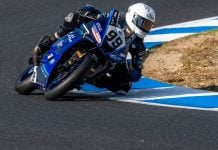FIRST PERSON/OPINION: By David Swarts In January of 2012, AMA Pro Racing announced that it would implement a hardware price cap of $18,000 per motorcycle for engine control and data acquisition electronics in the Superbike class, beginning with the 2013 season and continuing through 2015. The only previous restriction required that hardware be homologated and approved for use by AMA Pro Racing Technical Director Of Competition Al Ludington. But teams say that hardware cost is not the biggest concern, with the cost of buying or developing software and hiring qualified technicians to run the complicated systems making up the bulk of the expense. Yoshimura Racing admits to spending $300,000 per season on electronics hardware, software, development, testing and personnel for its two-rider effort in AMA Pro Superbike. Yoshimura uses Magneti Marelli Marvel 4 systems and employs multiple technicians to run the systems. Monster Energy Graves Yamaha also runs Magneti Marelli Marvel 4 systems on its Superbikes and employs multiple technicians, but says one technician is assigned to run the Magneti Marelli SRT systems it is now running on its Daytona SportBikes! Jordan Suzuki and National Guard Suzuki use Pectel systems run by multiple technicians, while KTM uses Magneti Marelli SRT systems run by a technician who flies in from Italy for each AMA Pro Superbike round. Most of the other Superbike teams use much-less-expensive, much-less-capable, readily available race-kit black boxes (a.k.a. Engine Control Units, or ECUs) that sell for less than $3500 including wiring harness. Examples include Suzuki’s EM Pro system for GSX-R1000s and Yamaha’s YEC system for YZF-R1s. The BMW kit box for the S1000RR sells for about $4000 and plugs into the standard wiring harness. The Kawasaki kit box and wiring harness for the ZX-10R sell for less than $1500. A KTM kit box and setting tool for the RC8 R sells for under $1200. An EBR kit box for the 1190RS sells for $750. Meetings held as recently as June between AMA Pro Racing officials and team representatives have revealed a deep divide in the paddock, with the majority of teams wanting to switch to kit boxes across the board, with a few notable holdouts. AMA Pro officials have openly stated that they established the 2013-2015 rule now on the books based on one winning team’s threat to quit the series if it wasn’t allowed to continue using the Magneti Marelli Marvel 4 system currently fitted to its racebikes. To check where the top-10 players (teams that had put riders in the top-10 in a race and were currently participating) in the AMA Pro Superbike class stood on electronics rules, we posed the following questions: 1. What should the AMA Pro Superbike electronic rules be for 2013-2015 and why? 2. What do you say to someone who claims they need a year or more notice to get ready for any rule change, including switching from the currently allowed advanced electronics to kit boxes? What we found was a clear majority in favor of going with more restrictive, race-kit-style black boxes, which they said would reduce costs, increase parity and serve the greater good of the sport. A minority said they wanted to keep using relatively expensive, advanced electronics because they had already bought the systems and because race-kit-style electronics would be difficult to police. Among those in favor of race-kit-style electronics and opposed to the AMA Pro Superbike electronics rule currently on the books for 2013 are: Foremost Insurance/Pegram Racing owner/rider Larry Pegram, who said he wants race-kit-style electronics to reduce cost and increase parity. Pegram also said he wanted AMA Pro Racing to consider going to a spec ECU for all bikes, like the system used in the British Superbike Championship, in two years. Pegram said he spent $60,000 trying to get expensive Pectel engine electronics to work on his BMW S1000RR in 2011, but gave up and switched back to BMW race kit electronics for 2012. ~https://www.roadracingworld.com/news/article/?article=48866~ Michael Jordan Motorsports Suzuki/National Guard Suzuki Team Manager Pete Mauhar, who said he’s in favor of race-kit-style electronics with piggyback fuel management devices and data acquisition, to reduce costs. Jordan Suzuki/National Guard Suzuki GSX-R1000s use advanced electronics from Pectel and Bazzaz. ~https://www.roadracingworld.com/news/article/?article=48867~ Team Hammer, Inc./M4 Suzuki/Team Venezuela General Manager/Crew Chief Keith Perry, who feels switching to less expensive race-kit-style electronics would help existing Superbike teams survive financially and may encourage new teams to step up to the AMA Pro Superbike class. Team Hammer uses Suzuki EM-Pro race kit black boxes on its Suzuki GSX-R1000 Superbikes. ~https://www.roadracingworld.com/news/article/?article=48870~ Kneedraggers.com/Motul/Fly Racing owner/rider “Aussie Dave” Anthony, who said allowing only race-kit-style electronics would “even things up a bit” out on the track. Anthony uses Suzuki EM Pro units on his team’s Suzuki GSX-R1000 Superbikes. ~https://www.roadracingworld.com/news/article/?article=48868~ Erik Buell Racing (EBR), Team Hero and Team Amsoil/Hero owner Erik Buell, who wants advanced electronics outlawed because they add to the cost of racing, decrease parity and do nothing to enhance the show for the fans or improve the products that customers actually buy. EBR uses $750 race kit ECUs (which do not have any rider aids) on the team’s 1190RS Superbikes. ~https://www.roadracingworld.com/news/article/?article=48886~ Farrell Performance owner/rider Jason Farrell, who is in favor of limiting Superbikes to less-costly race-kit-electronics, like the Kawasaki race kit ECU he used to finish sixth on his ZX-10R in Superbike Race One at Road America. ~https://www.roadracingworld.com/news/article/?article=48943~ Yoshimura Racing President Don Sakakura, who said that the 2013 electronics price cap will be ineffectual and that race-kit-style electronics will be “the quickest and easiest” way to ensure the health and possible growth of the AMA Pro Superbike paddock. And Yoshimura Racing Team Manager (and Crew Chief for Blake Young) Peter Doyle added that “MotoGP electronics” are not suitable in the current AMA Pro Superbike class, adding that the price cap rule “does not go far enough” and will not reduce costs. Yoshimura Racing uses advanced Magneti Marelli Marvel 4 electronics on the team’s GSX-R1000 Superbikes. ~https://www.roadracingworld.com/news/article/?article=48869~ Among those opposed to using race-kit-style electronics and in favor of the AMA Pro Superbike electronics rule currently on the books for 2013 are: Motorcycle-Superstore.com/LeoVince/Attack Performance Owner/Crew Chief Richard Stanboli, who said he thinks the price cap is a step in the right direction to control costs and a better alternative to homologated race-kit-style electronics, which he feels would be difficult to police. Stanboli also said using control ECUs is not a viable option due to the cost to teams and because different bikes need different systems to be tuned properly. Stanboli uses a MoTec system on his Kawasaki ZX-10R. ~https://www.roadracingworld.com/news/article/?article=48887~ KTM/HMC Racing Owner Mitch Hansen, who said that a premier class like Superbike should have unrestricted electronics and that it would be unfair to strip teams like his of the money and time they have invested in advanced electronics. KTM/HMC Racing uses Magneti Marelli SRT systems on its RC8 R Superbikes. ~https://www.roadracingworld.com/news/article/?article=48888~ And finally, Yamaha Motor Corp., U.S.A. Racing Division Manager Keith McCarty, who oversees the Monster Energy Graves Yamaha Superbike team owned by Chuck Graves; Graves also sells Magneti Marelli systems. McCarty stated that AMA Pro Racing officials came up with the 2013 electronics rule based on input from several sources, including Yamaha, and that “the rule is the rule.” McCarty also said that “We didn’t threaten anybody. We gave our points of view to the AMA…” and added that Roadracingworld.com polling Superbike team managers for their opinions on the 2013-2015 electronics rule was “misguided” and added, “shame on you guys.” Monster Energy Graves Yamaha uses Magneti Marelli Marvel 4 systems on its YZF-R1 Superbikes. ~https://www.roadracingworld.com/news/article/?article=49016~ That’s seven top-10 AMA Pro Superbike teams (fielding 13 riders) in favor of mandating homologated race-kit-style ECUs and data-logging systems to reduce costs, increase participation and enhance parity and the racing action, which could in turn attract more fans and sponsorship. That’s three top-10 AMA Pro Superbike teams (fielding 5 riders) in favor of the 2013-2015 Superbike electronics rule, including one owner who feels the rule is the best, most-enforceable option available; one owner who wants to protect his team’s investment; and one manager who was very defensive and irritated that the subject is even being discussed. In other words, that’s seven teams (fielding 13 riders) to three teams (fielding 5 riders) in favor of a rule limiting AMA Pro Superbikes to race-kit-style electronics in 2013. Actually, that’s not just a clear majority, that’s an overwhelming majority! That’s 70% in favor of a rule that seems like it would serve the greater good of AMA Pro Superbike. Meanwhile, the electronics price cap rule slated to be implemented in 2013 appears to only appease 30% (or three teams) that had put riders in the top 10 and continued to run in the series at the time of our poll. If you’re like me, you’re probably wondering how it even got to this point. Some partisans have accused Roadracingworld.com of purposely waiting to publish McCarty’s comments on behalf of Yamaha last in our multi-part poll, trying to make him out to be the bad guy. Some people think that explains McCarty’s defensive tone, a tone noticed and commented on by everyone who has spoken to me about the series of articles. But the truth of the matter is that I called McCarty and left him a voice mail during the same two-day span in which I spoke to nine of the other people in the poll — July 2-3. When I hadn’t gotten a response two days later, I e-mailed Yamaha road racing’s press officer and asked him to help me get in touch with McCarty. McCarty called me back that same day (July 5) and said he was busy and would comment on the poll when he got a chance, at a later date. I tried to reach McCarty again on July 9, before traveling to the AMA Pro Superbike National at Mid-Ohio, and was unsuccessful. Finally, on July 14 at Mid-Ohio, I walked up to McCarty in person in the paddock and recorded his comments, which were posted the next morning, July 15. In my lead, which appeared in every installment, I wrote: “AMA Pro officials have openly stated that they established the 2013-2015 rule now on the books based on one winning team’s threat to quit the series if it wasn’t allowed to continue using the Marvel 4 system currently fitted to its racebikes.” There are two teams that fit the description of a winning team that uses a Magneti Marelli Marvel 4 system, but only McCarty was openly defensive and referenced a threat. Why is that? Based on not-for-attribution conversations that I have had separately with multiple senior AMA Pro Racing officials, it is my personal belief that personnel representing Yamaha’s factory teams told senior AMA Pro Racing officials that Yamaha would not participate and would not support AMA Pro road racing in the future if they did not get things their way now. This isn’t just a theory I came up with on my own. One of the AMA Pro Racing officials who told me of Yamaha’s threats, also told multiple team managers the same thing: AMA Pro Racing had decided not to make meaningful changes in the electronics rules because Yamaha had threatened to quit the series, and AMA Pro could not afford to lose Yamaha. Earlier, that same official had promised the same team managers that the series would mandate kit boxes starting in 2013. (One of the same AMA Pro officials told me that Yamaha had also threatened to pull out of the series if Josh Herrin’s penalty following a collision with Dane Westby at Daytona in March 2011–a two-race suspension–was not reduced. That penalty was subsequently reduced to a one-race suspension.) Here are two obvious questions: Why would AMA Pro Racing cave in to one team’s threat? And why would senior AMA Pro Racing officials then go around telling people who own and manage competing teams that AMA Pro Racing had caved in to one team’s threat? In 2008, when professional road racing in America was on the verge of a potentially disastrous split between the existing, Daytona Motorsports Group-backed AMA Pro Racing series and the proposed, Motorcycle Industry Council-backed United States Super Bike (USSB) series, Yamaha was the first factory to state that it planned to continue to race with AMA Pro Racing. ~https://www.roadracingworld.com/news/article/?article=34120~ The USSB subsequently died before it issued its second press release. Meanwhile, as the economy nosed over, AMA Pro Racing stumbled through 2009 and finally achieved operational improvement and growth in participation, in spite of losing support from Honda and Kawasaki. Yamaha continued to race and also continued to buy commercials to support TV coverage of the series. That obviously helped. But that does not mean Yamaha should get preferential treatment or be given greater influence over the rules than the majority of other teams that put riders on the grid. AMA Pro officials now say they can’t go back to kit ECUs for 2013 despite what the majority of teams want, because they told Yamaha they wouldn’t. Yet the same AMA Pro officials promised other teams that they would mandate kit ECUs for 2013 and then reversed course based on Yamaha’s objections. In his response to Roadracingworld.com’s poll questions, McCarty said to me, “I think that the worst thing that could happen is changing once the rules are made, you go in there and try to re-invent the wheel and change it again just because one or two people disagree.” He could have been describing what happened when AMA Pro officials ignored the overwhelming majority opinion and reneged on promises to go to kit boxes–because McCarty objected! Obviously, McCarty had not kept up with the numbers in our poll findings, but I agree that making and changing rules without good reason can be counterproductive. In fact, I feel that AMA Pro Racing did itself and every stakeholder a great disservice in 2008 and 2009 by changing rules and policies mid-flight. But when something is obviously flawed – as evidenced by the overwhelming majority opinion being ignored and promises to go to kit boxes being abandoned — and teams are struggling to stay afloat due to economic conditions, it’s also the series promoter’s obligation to react to current reality. The second part of our poll asked: What would you say to those who claim they need a year or more notice to get ready for any rule change, including switching from the currently-allowed advanced electronics to race kit ECUs? Many thought it was a trick question and then explained that installing race-kit-style ECUs is a plug-and-play operation and that tuning them takes a competent race mechanical a matter of a few hours, if not significantly less. The way I see it, this is the situation: A majority of the top-10 players in AMA Pro Superbike want expensive electronics outlawed in favor of race-kit-style ECUs to reduce costs, enhance the show on the track and improve the product for spectators. Doing that would serve the greater good. Apparently, the only things standing in the way are: 1. Dealing with one threat; and, 2. issuing a competitor bulletin now, seven months before the start of the 2013 season–the same notice MotoGP officials have given CRT teams of the new, mandatory switch to spec ECUs for the 2013 season. What I don’t understand is why AMA Pro Racing hasn’t already changed course and done the right thing. To be continued…
Superbike Electronics: AMA Pro Team Managers Talk About What Rules Should Be For 2013 And Beyond, Part 11
Superbike Electronics: AMA Pro Team Managers Talk About What Rules Should Be For 2013 And Beyond, Part 11
© 2012, Roadracing World Publishing, Inc.






